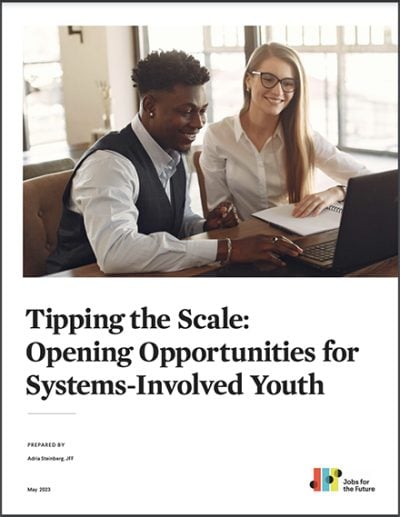Summary
The Annie E. Casey Foundation’s Learn and Earn to Achieve Potential (LEAP)™ initiative aims to help young people ages 14 through 25 succeed in school and at work by building and expanding education and employment pathways. All youth participating in LEAP have been involved in the child welfare or juvenile justice systems, are young parents or have experienced homelessness or housing instability.
About LEAP
Helping young people move onto education and employment pathways has long been the purview of overburdened public systems, with a scattering of smaller, more intensive programming available via nonprofits and various philanthropic efforts. The LEAP initiative takes a different approach. Since 2015, a set of local and national organizations with evidence-based models have collaborated to develop pathways that build on the assets of participating youth while also adapting to their particular needs. The initiative then seeks to embed these pathways in broader ecosystems of public-private partnerships.
Today, seven years into the initiative’s launch, its partners are focusing on spreading this model and the benefits of their work. This report, which packages information into three parts, explores the experiences and insights of LEAP partners who are working to deepen their practices while also scaling their efforts to help position more young people on pathways of opportunity.
Part One: Introducing Who and What
The document opens with a brief description of the national and local partners involved, spotlights how local partners have enhanced the LEAP model and introduces a set of six core elements of LEAP opportunity pathways that help define what is being advanced.
These six core elements are: 1) equity-centered and inclusive environments; 2) flexible learning experiences tailored to young peoples’ needs and responsive to the labor market; 3) youth-centered design; 4) support in meeting basic needs and navigating systems; 5) empowering relationships; and 6) formalized structures for collaboration and shared accountability.
Part Two: A Focus on Four Strategies
The second section of the report focuses on how the partnerships are carrying out the scaling work. Drawing examples from the LEAP partners, it identifies four different approaches to scaling opportunity. These are:
- Spreading strategies and practices across a multifaceted organization
- Expanding to additional populations
- Spreading geographically
- Working with public-sector partners to promote opportunity pathways
Two of these approaches — reaching out to additional or new populations and spreading geographically — constitute traditional approaches to scaling that look to develop a strong program and then use it with greater numbers of young people. The other two approaches focus on expanding best practices — not an entire program.
Part Three: Sharing Lessons From the Field
Although LEAP sites are still early in the scaling process, their experiences offer guideposts that may be of immediate use to other organizations and partnerships grappling with how to increase the impact of their social innovations. This is complex and long-term work, requiring commitments and consistent efforts from key stakeholders.
The final section of this report introduces five lessons that LEAP partners have already learned while working to grow their programs and practices. These lessons involve 1) centering the voices of young people; 2) clarifying what is being scaled; 3) staying nimble and strategic; 4) balancing fidelity and flexibility during growth; and 4) sustaining the commitment among all partners.






